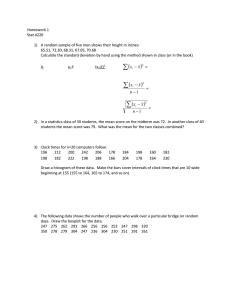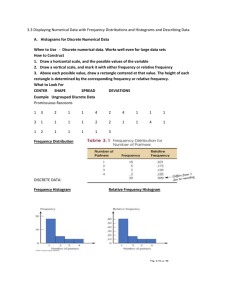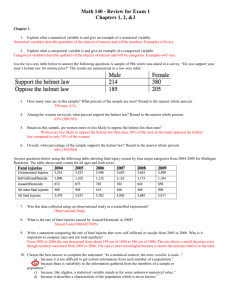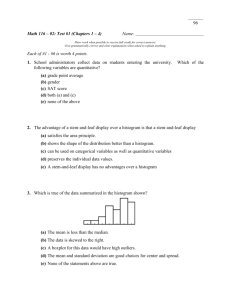Lecture 1
advertisement
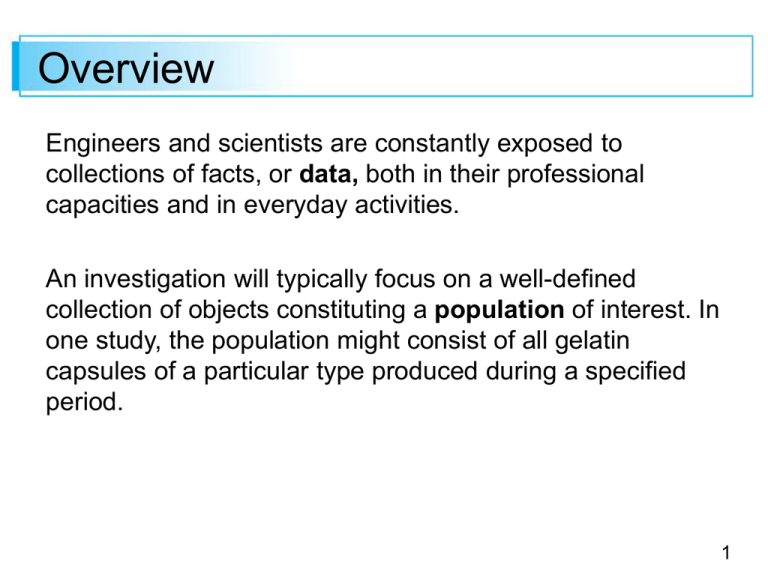
Overview
Engineers and scientists are constantly exposed to
collections of facts, or data, both in their professional
capacities and in everyday activities.
An investigation will typically focus on a well-defined
collection of objects constituting a population of interest. In
one study, the population might consist of all gelatin
capsules of a particular type produced during a specified
period.
1
Constraints on time, money, and other scarce resources
usually make a census impractical or infeasible. Instead, a
subset of the population—a sample—is selected in some
prescribed manner.
We are usually interested only in certain characteristics of
the objects in a population: the number of flaws on the
surface of each casing, the thickness of each capsule wall,
the gender of an engineering graduate, the age at which
the individual graduated, and so on.
2
A characteristic may be categorical, such as gender or type
of malfunction, or it may be numerical in nature.
In the former case, the value of the characteristic is a
category (e.g. female or insufficient solder), whereas in the
latter case, the value is a number (e.g., age = 23 or
diameter = .502 cm).
3
A variable is any characteristic whose value may change
from one object to another in the population. We shall
initially denote variables by lowercase letters from the end
of our alphabet. Examples include
x = brand of calculator owned by a student
y = number of visits to a particular Web site during a
specified period
z = braking distance of an automobile under specified
conditions
4
Data results from making observations either on a single
variable or simultaneously on two or more variables.
A univariate data set consists of observations on a single
variable.
For example, we might determine the type of transmission,
automatic (A) or manual (M), on each of ten automobiles
recently purchased at a certain dealership, resulting in the
categorical data set
M
A
A
A
M
A
A
M
A
A
5
Multivariate data arises when observations are made on
more than one variable.
For example, a research physician might determine the
systolic blood pressure, diastolic blood pressure, and
serum cholesterol level for each patient participating in a
study.
6
Example 1
cont’d
Figure 1.1 shows what is called a stem-and-leaf display as
well as a histogram.
A Minitab stem-and-leaf display (tenths digit truncated) and
histogram for the charity fundraising percentage data
Figure 1.1
7
Notation
The number of observations in a single sample, that is, the
sample size, will often be denoted by n, so that n = 4 for the
sample of universities {Stanford, Iowa State, Wyoming,
Rochester} .
If two samples are simultaneously under consideration,
either m and n or n1 and n2 can be used to denote the
numbers of observations.
8
Histogram, Bar Chart, Pie Chart
Variables can be either categorical or numerical.
A numerical variable is discrete if its set of possible values
either is finite or else can be listed in an infinite sequence.
A numerical variable is continuous if its possible values
consist of an entire interval on the number line.
Bar chart and pie chart are used for a categorical or a
discrete numerical variable.
Histogram is for a numerical variable, either discrete or
continuous.
9
Example 12
The weights (lb) of the 124 players listed on the rosters of
the San Francisco 49ers and the New England Patriots as
of Nov. 20, 2009.
NFL player weights Histogram
10
Histograms
11
Histogram Shapes
Histograms come in a variety of shapes. A unimodal
histogram is one that rises to a single peak and then
declines. A bimodal histogram has two different peaks.
Bimodality can occur when the data set consists of
observations on two quite different kinds of individuals or
objects.
12
The sample mean x of observations x1, x2,. . ., xn, is given
by
13
The word median is synonymous with “middle,” and the
sample median is indeed the middle value once the
observations are ordered from smallest to largest.
Quartiles divide the data set into four equal parts, Q1, Q2,
Q3.
Similarly, a data set can be even more finely divided using
percentiles; the 99th percentile separates the highest 1%
from the bottom 99%, and so on.
14
Measures of Variability for Sample Data
The sample variance, denoted by s2, is given by
The sample standard deviation, denoted by s, is the
(positive) square root of the variance:
Note that s2 and s are both nonnegative. The unit for s is
the same as the unit for the corresponding variable.
15
Boxplot
The data considered is the following sample of TN (total
nitrogen) loads (kg N/day) from a particular Chesapeake
Bay location, displayed here in increasing order.
16
Boxplot
The whiskers in the boxplot extend out to the smallest
observation, 9.69, on the low end and 312.45, the largest
observation that is not an outlier, on the upper end.
A boxplot of the nitrogen load data showing mild and extreme outliers
17
